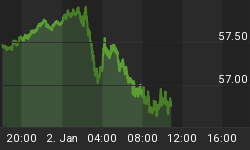Below is an excerpt from a commentary originally posted at www.speculative-investor.com on 22nd May 2011.
The price of gold is dominated by investment/monetary demand to such an extent that nothing else matters as far as gold's intermediate- and long-term price performance is concerned. Investment/monetary demand is probably also the most important driver of silver's price trend, although in silver's case industrial demand is also important. In addition, changes in mine supply have some effect on the silver market, because unlike the situation in the gold market the annual supply of newly-mined silver is not trivial relative to the existing aboveground supply of the metal.
Given that the change in annual mine supply is irrelevant to the gold price and is not close to being the most important driver of the silver price, why do some analysts argue that the gold/silver ratio should reflect the relative rarities of the two metals in the ground? We don't know, but it isn't a valid argument.
Another popular argument that we think is invalid is that the gold/silver ratio should be around 16:1 because that's what it was for hundreds of years prior to the last hundred years. The fact is that due to changes in technology and changes in the monetary system, permanent changes occur in the relative values of different commodities and different investments. For example, when monetary inflation was constrained by the Gold Standard the stock market's average dividend yield was always higher than the average yield on long-dated bonds, but the 1934-1971 phasing-out of the official link to gold permanently altered this relationship. In a world where governments and central banks can and do inflate at will, the stock market will almost always yield less than the bond market because stocks have some built-in protection against inflation. The point we are trying to make is that the ratio of gold and silver during an historical period in which both metals were officially "money" does not tell us what the ratio should be now that neither metal is officially money and one of the metals (silver) has an important industrial demand component.
The global monetary system's current configuration dates back to the early 1970s, when the last remaining official link between gold and the US$ was severed. This probably means that we can look at how gold and silver have performed relative to each other since the early 1970s to determine what's normal and what's possible. With reference to the following chart, here's a summary of what happened during this period:
a) The gold/silver ratio spent the bulk of the 1970s in the 30-40 range, but broke out of this range to the downside during the second half of 1979 in response to massive accumulation of silver bullion and silver futures by the Hunt brothers.
b) The ratio dropped as low as 16:1 in January of 1980, but then returned to 40 in the 'blink of an eye' as rule changes by the commodity exchange created financial problems for the highly-geared Hunts.
c) During the second half of the 1980s the ratio trended upward as US financial corporations weakened. The ratio peaked at around 100 at the beginning of 1990s in parallel with a full-blown banking crisis that almost resulted in the collapse of some of the US's largest banks.
d) The ratio trended lower throughout the 1990s as the banks recovered (with the help of the Fed) and financial assets trended upward.
e) From the late 1990s through to the beginning of this year the ratio oscillated between 45 and 80, with 80 being reached near the peaks of financial crises (early-2003 and late-2008) and 45 being reached in response to generally high levels of economic confidence.
f) In February of this year the ratio broke below the bottom of its long-term range and rapidly moved down to around 30. The huge price run-up in silver that led to this large and fast decline in the gold/silver ratio was fueled by the overt bullishness of a very well-heeled speculator (Eric Sprott) and by various rumours, including rumours of silver shortages and the unwinding of a price-suppression scheme led by JP Morgan.
g) The 2010-2011 parabolic advance in the silver price ended the same way that every similar episode in world history ended -- with a price collapse. The ratio has since moved back above 40.

The gold/silver ratio's performance over the past four decades suggests that the 40-55 range can now be considered normal, with moves well beyond the top of this range requiring a financial crisis and/or major problems within the banking industry and moves well beyond the bottom of this range requiring rampant speculation focused on silver.
We aren't offering a free trial subscription at this time, but free samples of our work (excerpts from our regular commentaries) can be viewed at: http://www.speculative-investor.com/new/freesamples.html
















